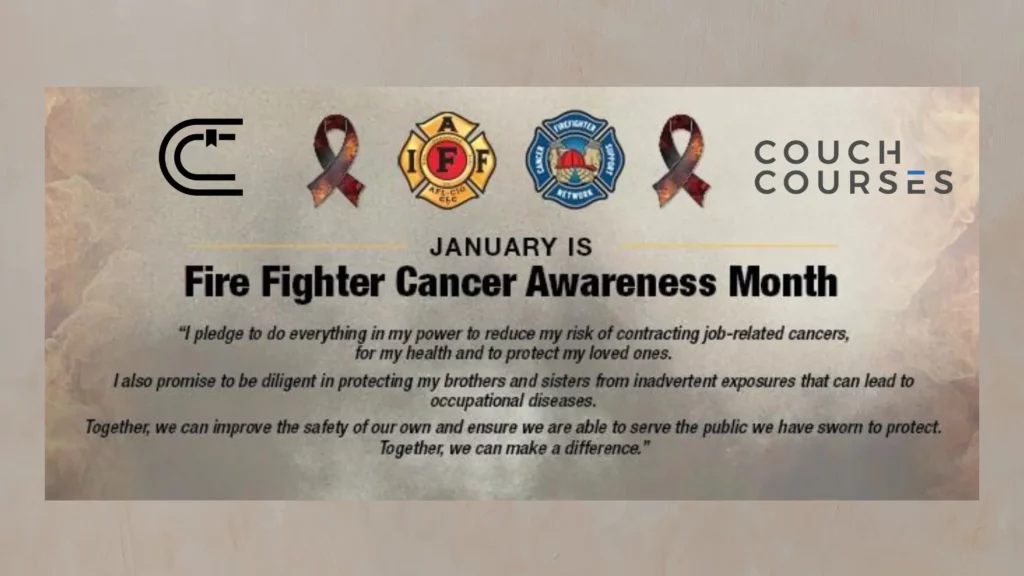Cancer Awareness In The Fire Service

What, cancer awareness? Do we really need to know about this?
We hear it all the time, how dangerous it is to be a firefighter. People always say things like, “Firefighters run in when everyone else is running out!” It’s true, we go where most wouldn’t.
Yeah we have firefighting gear on; yeah we have SCBA’s to breath clean air; and yes we have gas monitors to help us identify carbon monoxide and some other toxic gases in the air. All 3 of these are important in keeping us safe by protecting us from heat, smoke, and other toxic gases during firefighting.
What about after the fire? What about all the things we can’t see or feel immediately? Like carcinogens and hydrocarbons? Not sure exactly what these are and how to stay safe? Then continue reading our discussion on firefighter cancer awareness.

What Are Carcinogens?
Firefighters throw around words like carcinogen a lot without explaining it. Simply stated, a carcinogen is any substance capable of causing cancer in a living tissue.
We typically think of smoke and all the toxic gases and byproducts of combustion as being the cancer causer. This is true, smoke is unburnt fuel and contains carbon monoxide, carbon dioxide, and small particles we refer to as ‘soot’; along with millions of different toxic chemicals.
Tell me, is there anything wrong with the picture shown here? I see fire. I see smoke. I see a firefighter walking with all his protective gear, mask, and SCBA available but not being used. This is something we need to stop from occurring on our fire scenes.
What Are Hydrocarbons?
Hydrocarbons are organic compounds consisting of hydrogen and carbon. In firefighting, we are concerned with polycyclic aromatic hydrocarbons (PAH).
Firefighters can be exposed to PAHs through absorption in the skin, inhaled directly from a fire scene, or inhaled from off-gassing gear and equipment after a fire.
-AND-
If you didn’t think that was enough….vehicle and equipment exhaust exposure doesn’t involve being at a fire at all. Running apparatus and equipment in the bay can cause absorption and inhalation of PAHs into the body.
What do PAHs do to humans? They can cause cardiovascular issues, pulmonary issues, and cancers in humans.

What Are Polyfluoroalkyl Substances (PFAS)?
What is this? PFAS? The definition is extensive, so let’s keep it simple. PFAS are chemicals used in the manufacturing process of firefighter bunker gear that help repel oil and water. Sounds good right? Well, not so fast. Now, in recent studies, they have found that gear that has this product in it poses a health risk. Why? Because it causes cancer.
Read this article to learn more: IAFF and Metro Chiefs issue joint statement on health risks from chemicals in firefighter turnout gear.
What Is Our Risk?
The risk of cancer runs higher for firefighters if you didn’t already know. Watch the video to learn more about the statistics.
The Firefighter Cancer Support Network is available to assist firefighters and EMS providers and their immediate families diagnosed with cancer by providing badge to badge support, training and guidance.
The IAFF Scope Of The Cancer Problem PowerPoint
The IAFF discusses in some depth the issues with cancer and the fire service. Take a moment to view their PowerPoint.
5 Ways To Reduce Your Cancer Risk
Here are a few simple takeaways on how to REDUCE your risk of cancer as a firefighter.
- Reduce diesel exhaust exposure:
- Use a containment or removal system
- Keep fresh air circulating by opening bay doors and/or checking apparatus and equipment outside
- Keep living quarters doors closed/sealed
- Act cautious at the fireground:
- Don’t rely strictly on gas meters to determine the safety of the environment
- Wear PPE per SOP at all vehicle and structure fires
- Caring for PPE/SCBA:
- Clean and inspect for damage PPE/SCBA after every fire and as recommended by manufacturer
- Test SCBA daily
- Use SCBA throughout and during overhaul, and any exterior operations where exposure occur
- Perform decontamination while on SCBA
- NEVER wash gear at home or public laundromat
- Store PPE correctly:
- Nowhere near living quarters
- When returning to the station, store gear in outside compartment or airtight container if it must be stored in the cab area
- Use airtight container if transporting in personal vehicle
- Wash after a fire:
- Use wet wipes to wipe exposed face, hands, head, and neck at the fire ground.
- Shower after cleaning equipment upon return to the station
- Wear clean clothes after showering
Tips On Cleaning Gear
We always recommend following your manufacturers directions on use, maintenance, and storage of your PPE, equipment, and apparatus. Take the time to learn how to clean your gear per NFPA 1581.
Couch Courses Safety Officer Classes
Remember that every January is Firefighter Cancer Awareness Month. Interested in other ways to stay safe in the fire service? Learn about safety in our Safety Officer Courses:
Florida Health & Safety Officer course ATPC6741
Incident Safety Officer course ATPC6742
These courses cover a multitude of incident, health and safety topics in depth that help increase firefighter safety.
Be sure to follow Couch Courses on Facebook, Instagram, Twitter, and LinkedIn for special offers, new courses, and more!





